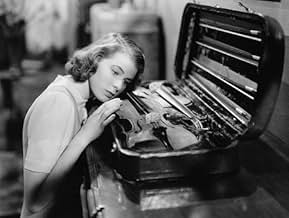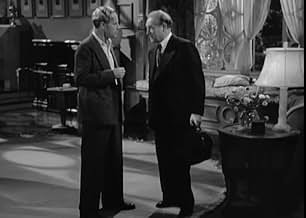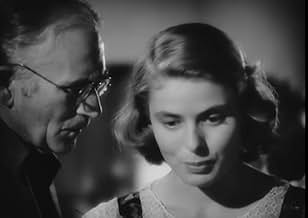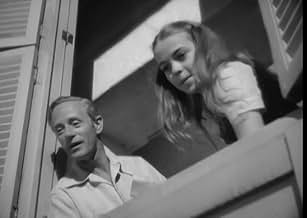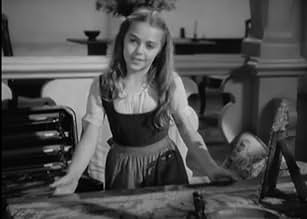Aggiungi una trama nella tua linguaA violinist's piano accompanist retires. He hears his daughter's piano teacher (Ingrid Bergman) play, asks her to play on his next international tour, and they fall in love.A violinist's piano accompanist retires. He hears his daughter's piano teacher (Ingrid Bergman) play, asks her to play on his next international tour, and they fall in love.A violinist's piano accompanist retires. He hears his daughter's piano teacher (Ingrid Bergman) play, asks her to play on his next international tour, and they fall in love.
- Regia
- Sceneggiatura
- Star
- Candidato a 1 Oscar
- 3 vittorie e 1 candidatura in totale
- Ann Marie Brandt - Their Daughter
- (as Ann Todd)
- Schoolgirl
- (non citato nei titoli originali)
Recensioni in evidenza
Much of the story has to do with the guilt they both experience in terms of the familial repercussions, and the ending reflects as much. A role away from his Ashley Wilkes in "Gone With the Wind", obviously the more important Selznick movie in production a the time, Leslie Howard plays Holger in his familiar erudite manner. Veteran character actor Cecil Kellaway (later the monsignor in "Guess Who's Coming to Dinner") plays the sage maestro who acts as the film's conscience. Scenes often seem strangely truncated to move the story briskly along. Beyond Bergman, the most accomplished aspects of the film are Gregg Toland's lush cinematography, Lyle Wheeler's art direction (making Monterey, California look very much like the Italian Riviera) and Max Steiner's romantic music (oddly uncredited). But the impossibly striking Bergman is the primary reason to see this predictably developed film. The 2004 DVD offers no extras.
The debut of Ingrid Bergman in an English spoken film may be dated in 2006, but it is still a wonderful romance about a man in a middle age crisis, with a stabilized marriage, who sparks with the love of a talented gorgeous woman that worships him. The performances of Ingrid Bergman, Leslie Howard and Ann Todd are fantastic, and Ingrid looks like a pianist in the sequence in the birthday party. Her beauty shines in the awesome black and white photography and locations and her accent is lovely. The music score gives an additional touch of class to this film. The moralist conclusion seems suitable for the values of the society of 1939, leaving a message of forgiveness and understanding. My vote is eight.
Title (Brazil): "Intermezzo"
Off the cuff, here are seven reasons why:
1) There IS a good message here: that a married person having a fling with a pretty young woman might be an exciting prospect but in the end, "you reap what you sow" and if either of the two parties has a conscience, the illicit romance will be doomed, especially if there are kids involved.
2 ) For male viewers, Ingrid Bergman, making her English-speaking debut, is a real feast for the eyes. She was one of the more naturally gorgeous women to grace the silver screen, I think.
3) Gregg Toland's photography. To fully appreciate his work, get the DVD for this film. Toland was one of the best ever, and this is a beautifully shot piece of work.
4) At 70 minutes, the film flies by, which also makes it easier to watch and enjoy multiple times.
5) Leslie Howard and John Halliday also were excellent in here as the two male leads. I thought Halliday, in particular, had some great words of wisdom.
6) For those who appreciate how difficult it is to forgive people, this ending contained another nice message.
7) Classical music lovers will very much appreciate the soundtrack to this film.
This was a remake of a 1936 Swedish film that had also starred Bergman. This was an important film to Howard, who took the role of Ashley in Selznick's Gone with the Wind in order to get this movie made. It's more than a little corny, and I found the score to be intrusive and manipulative to an almost laughable degree. I also liked the initial "love" scene between Howard and Bergman, when she plays piano accompaniment to his violin playing, the two in deep concentration, while his horrified family and friends look on as if the two musicians are literally having sex in front of them. It's amusing, but not in the way it was intended, I would think. The movie earned two Oscar nominations, for Best Cinematography and Best Score.
The film is a remake in Hollywood style of a Swedish film directed by Gustaf Molander in 1936 and equally interpreted by Ingrid Bergman ; here plays his first US role , in fact , is best known as Bergman's American debut and became her in world star . Bergman is splendid and enticing , stunningly photographed by the maestro Gregg Toland (Citizen Kane) and she obtained extraordinary reviews . Leslie Howard is agreeable and sensible as the lover who bears a guilty feeling . Fine support cast is formed by Ann Todd as the daughter who strongly loves her daddy , Cecil Kellaway in one his usual roles as likable and comical friend and John Halliday . Excellent black and white cinematography and magnificent musical score by the master Max Steiner , nominated for Academy Award and being added classic music composed by Provost , Rachmaninov and Tchaykowsky . The motion picture will appeal to romantic films buffs and vintage cinema enthusiasts . Rating : Above average . Outstanding and enjoyable.
Lo sapevi?
- QuizAfter Producer David O. Selznick fired Cinematographer Harry Stradling Sr. and hired Gregg Toland to take over the photography of this, the remake of La sposa scomparsa (1936), he asked Toland how it was possible that Ingrid Bergman looked so beautiful in the original European production and so ghastly in his Hollywood version. Toland replied, "In Sweden they don't make her wear all that makeup." Selznick immediately ordered retakes with the natural look which so dazzled the world a year later when he loaned her out to Warner Bros. for Casablanca (1942).
- Blooper(at around 32 mins) When Holger and Anita are standing outside the shop and looking at the "curious clock", their faces can be seen reflected in the shop window. As they continue their parting conversation, Anita's mouth movement suddenly mismatches what she can be heard saying. This is followed by a mixture of audible dialogue and interspersed mouth movements from both characters that produce no sound.
- Citazioni
Charles Moler: [cutting into Ann Marie's birthday cake] You know what? Not so long ago your daddy and I went to a birthday party in China.
Ann Marie Brandt: In *China*?
Charles Moler: [thinking about the pronunciation] Uh-huh. At a Mandarin's house. His name was Chou Ching Chang Chip Chop.
Ann Marie Brandt: Did you have ice cream and cake?
Charles Moler: Oooh, no, indeed. We had swallows' nests, umm, roasted silkworms, snake soup and, uh... cricket eggs!
Ann Marie Brandt: Oh! You didn't eat *that*...?
Charles Moler: Oh, we had to take a double helping of everything, or the Mandarin would've murdered us.
Ann Marie Brandt: Oh, well, Uncle Charles, nobody will murder you here!
- Curiosità sui creditiAnd introducing Ingrid Bergman.
- Versioni alternativeA re-release uses the title "Intermezzo" and lists the copyright owner as "Vanguard Films, Inc.", which was Selznick's company name in the 1940s. Ingrid Bergman is billed first in the opening credits, which also are more elaborate than the original release. The end cast credits, however, are identical.
- ConnessioniFeatured in Hollywood: The Selznick Years (1969)
- Colonne sonoreIntermezzo
(1936) (uncredited)
Music by Heinz Provost
Played at the concert by Leslie Howard on violin and John Halliday on piano
Played by Howard and Ann E. Todd on piano at their home
Played by Howard and Ingrid Bergman on piano at a concert
Played on a zither by Howard
Used as background music often
I più visti
- How long is Intermezzo?Powered by Alexa
Dettagli
Botteghino
- Budget
- 800.000 USD (previsto)
- Tempo di esecuzione1 ora 10 minuti
- Colore
- Proporzioni
- 1.33 : 1
Contribuisci a questa pagina



